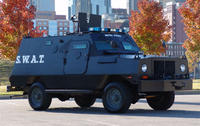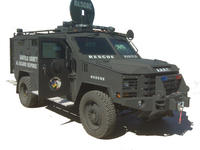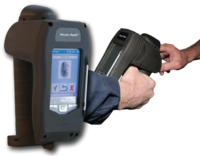-
Clip-on camera helps Mississippi police
The small police force at Walls, Mississippi, has technology on its side: a $60 clip-on camera, the size of a pack of gum, which the officer attaches to the front pocket of his or her uniform; the cameras hold a small memory card, capable of recording hours of evidence; the cameras have never been challenged in court
-
-
Butte County police lobbies for armored vehicle

For the second year in a row local law enforcement officials in Butte County, California are rallying to obtain grant money to help purchase an armored vehicle; if money from 2011 DHS grants is allocated to Butte County by the state, officials say it would be used to purchase an armored vehicle for the Butte County Sherriff’s Office and Chico
-
-
New Haven, Connecticut police begin installing security cameras
New Haven police plan to install twenty-one surveillance cameras in the city’s hot spots for crime. The cameras will give officers a 360 degree view of an area’s streets and sidewalks; police hope that the cameras will help reduce New Haven’s rising violent crime rate; in the first half of 2011, more than eighteen people have been killed
-
-
Austin fights to keep federal money to battle cartels
With federal lawmakers struggling to reduce spending and cut the deficit, Austin, Texas, could lose as much as $2 million in federal grant money that it uses to combat Mexican drug cartels; on Tuesday, Austin police chief Art Acevedo and Representative Michael McCaul (R-Texas) urged lawmakers not to cut their funding citing the fact that the city is a dangerous hub for drug cartels
-
-
U.S. spends $90 billion on border security, drugs keep pouring in
A recent study found the United States has spent an estimated $90 billion over the past decade to secure the U.S - Mexico border with mixed results;annual border spending had tripled over the last decade; the increased spending has helped curb illegal immigration, but for Mexican drug cartels business is booming and they are smuggling more drugs than ever into the United States
-
-
SWAT Team in Washington acquires heavily armored vehicle

The Tri-City Regional SWAT Team in Tacoma, Washington recently received a major boost to its arsenal of crime fighting tools;thanks to DHS grants, the Tri-City Regional Swat Team was able to purchase the BearCat, a $292,000 armored personnel carrier; the vehicle is heavily armored and is capable of stopping .30-caliber ammunition
-
-
Wireless fingerprint readers help police fight crime

Using a new wireless device, police across the country are now able to quickly and accurately identify a suspect in the field; using RapID, a small handheld unit, officers can read a suspect’s fingerprint and check it against a database for any matches; if any matches are found the device will pull up the person’s real name, date of birth, gender, and race, making it more difficult for criminals to use a false identity
-
-
DHS urges greater vigilance for Independence Day, but no threats
As Americans across the United States prepare to celebrate the nation’s birth on 4 July, DHS is urging law enforcement agencies and individuals to remain vigilant; in its latest Security Awareness bulletin, DHS is careful to note that there is no “specific or credible information” that al Qaeda is planning an attack, but did say that al Qaeda had aspired to execute attacks on the symbolic holiday
-
-
Documents reveal drug cartels' secret weapons, techniques

The recent attack on Arizona’s Department of Public Safety by LulzSec has revealed that law enforcement officials in the Southwest are battling drug cartels that use a variety of sleek gadgets and hidden weapons; the sensitive documents published by LulzSec show that smugglers have become increasingly clever using a variety of methods to sneak drugs past border officials; the cartels have hollowed out cell phones to plant 180,000 volt stun guns or a .22 caliber pistol
-
-
New radar gun spots tailgaters
Tailgating has long been a dangerous practice causing many fatal highway accidents, yet law enforcement agencies have struggled to effectively enforce the law as they lacked the proper equipment to document and prosecute violators;without definitive proof, cases involving tailgating were difficult to win in court, but a Colorado based company may have sold this problem; Laser Technology Inc. (LTI) has developed a device it calls Distance Between Cars (DBC)
-
-
Supreme Court to hear GPS tracking case
The 220-year old Fourth Amendment to the Constitution offers protection against unreasonable searches; the Supreme Court agreed to hear a case involving the police secretly attaching a GPS device to a suspect’s car to monitor his movement; the question before the Court: does the secret placement of a GPS device on a suspect’s car in order to keep tabs on him for an extended period of time require a search warrant
-
-
Battle over gun microstamping bill heats up in New York

New York is locked in a fierce political battle over proposed legislation that would require all guns sold and manufactured in the state to use “microstamping” technology; law enforcement officials favor the bill as it would provide investigators with valuable leads; Pro-gun advocates have staunchly opposed microstamping stating that the technology is flawed, threatens the rights of gun owners, and is expensive
-
-
Arizona police network latest LulzSec cyber victim
In the latest string of attacks on government computer networks by LulzSec, an international hacker network, the Arizona Department of Public Safety’s computer network was broken into and the group is publicly releasing hundreds of law enforcement documents
-
-
Marine reservist arrested outside Pentagon, suspicious vehicle found

Authorities apprehended Lance Corporal Yonathan Melaku early Friday morning after he was found at Arlington National Cemetery while it was still closed; authorities discovered that the suspect was carrying a notebook that contained the phrases “al Qaeda,” “Taliban rules,” and “Mujahid defeated croatian forces”; law enforcement officials say that despite the evidence found, Melaku is not believed to be involved in a terrorist plot
-
-
ShotSpotter raises $10.5 million
On Thursday, ShotSpotter, Inc., the manufacturers of gunshot location and detection technology, announced that it had raised $7 million in equity and expanded its credit facility by $3.5 million; with the additional funds, ShotSpotter will expand its flagship product the ShotSpotter GunSpotter Location System in international markets
-
More headlines
The long view
Why Was Pacific Northwest Home to So Many Serial Killers?
By Jacob Sweet
Ted Bundy, Gary Ridgway, George Russell, Israel Keyes, and Robert Lee Yates were serial killers who grew up in the Pacific Northwest in the shadow of smelters which spewed plumes of lead, arsenic, and cadmium into the air. As a young man, Charles Manson spent ten years at a nearby prison, where lead has seeped into the soil. The idea of a correlation between early exposure to lead and higher crime rates is not new. Fraser doesn’t explicitly support the lead-crime hypothesis, but in a nimble, haunting narrative, she argues that the connections between an unfettered pollution and violent crime warrant scrutiny.
